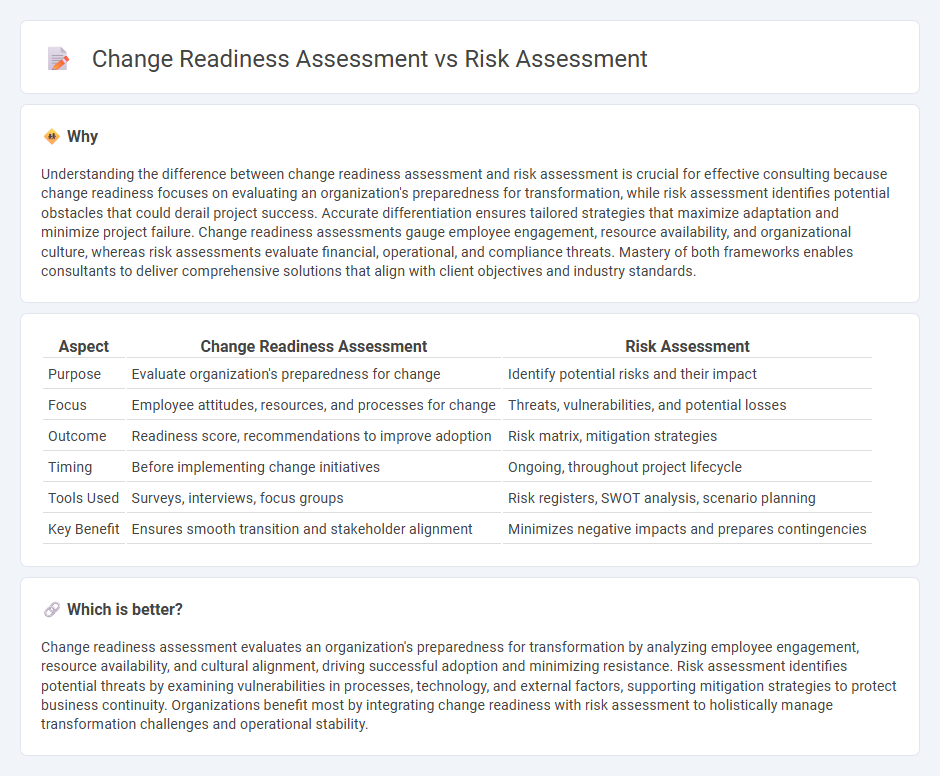
Change readiness assessment evaluates an organization's capacity to adapt to new initiatives by measuring employee engagement, resource allocation, and leadership support, essential for successful transformation. Risk assessment identifies potential threats and vulnerabilities within business processes, focusing on mitigating financial, operational, and compliance risks. Discover how combining these assessments can enhance strategic decision-making and drive effective change management.
Why it is important
Understanding the difference between change readiness assessment and risk assessment is crucial for effective consulting because change readiness focuses on evaluating an organization's preparedness for transformation, while risk assessment identifies potential obstacles that could derail project success. Accurate differentiation ensures tailored strategies that maximize adaptation and minimize project failure. Change readiness assessments gauge employee engagement, resource availability, and organizational culture, whereas risk assessments evaluate financial, operational, and compliance threats. Mastery of both frameworks enables consultants to deliver comprehensive solutions that align with client objectives and industry standards.
Comparison Table
| Aspect | Change Readiness Assessment | Risk Assessment |
|---|---|---|
| Purpose | Evaluate organization's preparedness for change | Identify potential risks and their impact |
| Focus | Employee attitudes, resources, and processes for change | Threats, vulnerabilities, and potential losses |
| Outcome | Readiness score, recommendations to improve adoption | Risk matrix, mitigation strategies |
| Timing | Before implementing change initiatives | Ongoing, throughout project lifecycle |
| Tools Used | Surveys, interviews, focus groups | Risk registers, SWOT analysis, scenario planning |
| Key Benefit | Ensures smooth transition and stakeholder alignment | Minimizes negative impacts and prepares contingencies |
Which is better?
Change readiness assessment evaluates an organization's preparedness for transformation by analyzing employee engagement, resource availability, and cultural alignment, driving successful adoption and minimizing resistance. Risk assessment identifies potential threats by examining vulnerabilities in processes, technology, and external factors, supporting mitigation strategies to protect business continuity. Organizations benefit most by integrating change readiness with risk assessment to holistically manage transformation challenges and operational stability.
Connection
Change readiness assessment evaluates an organization's preparedness for transformation by analyzing factors such as employee adaptability, resource availability, and leadership alignment. Risk assessment identifies potential obstacles and vulnerabilities that could hinder successful change implementation, including operational, financial, and cultural risks. Integrating both assessments enables consultants to develop comprehensive strategies that mitigate risks while enhancing organizational capacity for smooth and effective change adoption.
Key Terms
**Risk Assessment:**
Risk assessment systematically identifies, analyzes, and evaluates potential threats that could negatively impact project objectives, operations, or organizational assets. It prioritizes risks based on their probability and potential impact using qualitative and quantitative methods such as risk matrices or failure mode effects analysis (FMEA). Explore comprehensive strategies to enhance your understanding of risk management frameworks and best practices.
Hazard Identification
Risk assessment prioritizes hazard identification by systematically analyzing potential threats to safety, health, and operations, quantifying risk levels based on likelihood and impact. Change readiness assessment focuses on identifying hazards related to organizational, cultural, and operational changes, evaluating how prepared individuals and systems are to handle those risks effectively. Explore detailed methodologies and best practices to enhance your understanding of hazard identification across both assessments.
Probability Analysis
Risk assessment emphasizes probability analysis to identify and quantify potential threats by evaluating the likelihood and impact of adverse events. Change readiness assessment uses probability analysis to gauge an organization's preparedness for successful adoption of change, focusing on factors influencing acceptance and resistance. Explore comprehensive strategies to effectively integrate probability analysis in both assessments for optimal decision-making.
Source and External Links
Risk assessment - Wikipedia - Risk assessment is a process for identifying hazards, analyzing their likelihood and consequences, and determining actions to mitigate negative impacts on individuals, assets, or the environment, forming a key part of risk management strategy.
Risk Assessment: Process, Tools, & Techniques | SafetyCulture - A risk assessment systematically identifies hazards, analyzes potential impacts, and helps prioritize control measures to ensure workplace safety and compliance with regulations like OSHA.
Risk assessment: Steps needed to manage risk - HSE - Managing risk involves a step-by-step process of identifying hazards, assessing associated risks, controlling them, recording findings, and reviewing controls to protect health and safety in the workplace.
 dowidth.com
dowidth.com